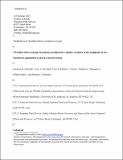Files in this item
Weather-driven change in primary productivity explains variation in the amplitude of two herbivore population cycles in a boreal system
Item metadata
| dc.contributor.author | Schmidt, Joshua H. | |
| dc.contributor.author | Rexstad, Eric A. | |
| dc.contributor.author | Roland, Carl A. | |
| dc.contributor.author | McIntyre, Carol L. | |
| dc.contributor.author | MacCluskie, Margaret C. | |
| dc.contributor.author | Flamme, Melanie J. | |
| dc.date.accessioned | 2018-11-23T00:49:42Z | |
| dc.date.available | 2018-11-23T00:49:42Z | |
| dc.date.issued | 2018-02 | |
| dc.identifier | 251637086 | |
| dc.identifier | 2e6022c0-49de-4f5a-a34e-9c295602ab29 | |
| dc.identifier | 000424210100013 | |
| dc.identifier | 85034755611 | |
| dc.identifier | 000424210100013 | |
| dc.identifier.citation | Schmidt , J H , Rexstad , E A , Roland , C A , McIntyre , C L , MacCluskie , M C & Flamme , M J 2018 , ' Weather-driven change in primary productivity explains variation in the amplitude of two herbivore population cycles in a boreal system ' , Oecologia , vol. 186 , no. 2 , pp. 435-446 . https://doi.org/10.1007/s00442-017-4004-3 | en |
| dc.identifier.issn | 0029-8549 | |
| dc.identifier.other | ORCID: /0000-0002-4323-8161/work/39245044 | |
| dc.identifier.uri | https://hdl.handle.net/10023/16531 | |
| dc.description.abstract | Vertebrate populations throughout the circumpolar north often exhibit cyclic dynamics, and predation is generally considered to be a primary driver of these cycles in a variety of herbivore species. However, weather and climate play a role in entraining cycles over broad landscapes and may alter cyclic dynamics, although the mechanism by which these processes operate is uncertain. Experimental and observational work has suggested that weather influences primary productivity over multi-year time periods, suggesting a pathway through which weather and climate may influence cyclic herbivore dynamics. Using long-term monitoring data, we investigated the relationships among multi-year weather conditions, measures of primary productivity, and the abundance of two cyclic herbivore species: snowshoe hare and northern red-backed vole. We found that precipitation (rain and snow) and growing season temperatures were strongly associated with variation in primary productivity over multi-year time horizons. In turn, fourfold variation in the amplitude of both the hare and vole cycles observed in our study area corresponded to long-term changes in primary productivity. The congruence of our results for these two species suggests a general mechanism by which weather and climate might influence cyclic herbivore population dynamics. Our findings also suggested that the association between climate warming and the disappearance of cycles might be initiated by changes in primary productivity. This work provides an explanation for observed influences of weather and climate on primary productivity and population cycles and will help our collective understanding of how future climate warming may influence these ecological phenomena in the future. | |
| dc.format.extent | 12 | |
| dc.format.extent | 719169 | |
| dc.language.iso | eng | |
| dc.relation.ispartof | Oecologia | en |
| dc.subject | Alaska | en |
| dc.subject | Bottom-up | en |
| dc.subject | Denali National Park | en |
| dc.subject | Growing degree days | en |
| dc.subject | Population dynamics | en |
| dc.subject | Precipitation | en |
| dc.subject | Primary productivity | en |
| dc.subject | Red-backed vole | en |
| dc.subject | Snowshow hare | en |
| dc.subject | GE Environmental Sciences | en |
| dc.subject | QH301 Biology | en |
| dc.subject | QL Zoology | en |
| dc.subject | NDAS | en |
| dc.subject | SDG 13 - Climate Action | en |
| dc.subject.lcc | GE | en |
| dc.subject.lcc | QH301 | en |
| dc.subject.lcc | QL | en |
| dc.title | Weather-driven change in primary productivity explains variation in the amplitude of two herbivore population cycles in a boreal system | en |
| dc.type | Journal article | en |
| dc.contributor.institution | University of St Andrews. School of Mathematics and Statistics | en |
| dc.contributor.institution | University of St Andrews. Scottish Oceans Institute | en |
| dc.contributor.institution | University of St Andrews. Centre for Research into Ecological & Environmental Modelling | en |
| dc.identifier.doi | 10.1007/s00442-017-4004-3 | |
| dc.description.status | Peer reviewed | en |
| dc.date.embargoedUntil | 2018-11-23 |
This item appears in the following Collection(s)
Items in the St Andrews Research Repository are protected by copyright, with all rights reserved, unless otherwise indicated.

